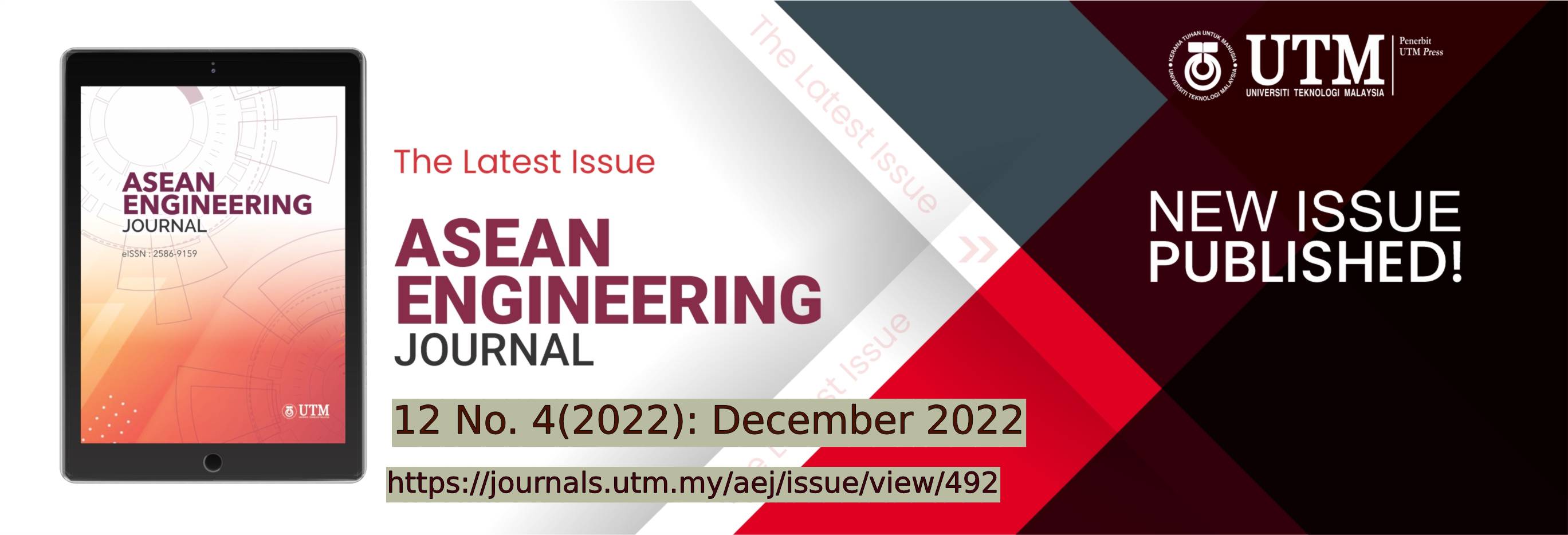PREPARATION OF ACTIVATED CARBON FROM TIRE DERIVED PYROLYTIC CHAR FOR ADSORPTION OF TETRACYCLINE HYDROCHLORIDE
DOI:
https://doi.org/10.11113/aej.v12.18437Keywords:
activated carbon, adsorption, empirical model, tetracycline, waste tireAbstract
Effects of activation variables on performance of the obtained activated carbon (AC) were investigated for removal of tetracycline hydrochloride (TCH). Pyrolytic char derived from waste tire was chemically activated via two-step of KOH impregnation following by thermal treatment. According to regression analysis and fitting with second-degree polynomial equation, empirical models were developed to correlate performance of AC in TCH adsorption (percentage removal and adsorption capacity at equilibrium) with three activation variables: impregnation ratio (IR), activation temperature (T) and holding time of thermal treatment (t). The analysis of variance indicated that only T, T2 and IR2 were significant to the prediction of both percentage removal and adsorption capacity. According to the developed models, it is suggested that the pyrolytic char should be activated at IR = 6, T = 750 °C and t = 2 h to obtain the highest efficiency of TCH removal in the tested range of activation condition.
References
Daghrir, R. and Drogui, P. 2013. Tetracycline antibiotics in the environment: a review. Environ Chem Lett. 11: 209–227.
Scaria, J., Anupama, K. V. and Nidheesh, P. V. 2021. Tetracyclines in the environment: An overview on the occurrence, fate, toxicity, detection, removal methods, and sludge management. Science of The Total Environment. 771(1): 145291. DOI: https://doi.org/10.1016/j.scitotenv.2021.145291
Aslam, B., Wang, W., Arshad, M. I., Khurshid, M., Muzammil, S., Rasool, M. H., Nisar, M. A., Alvi, R. F., Aslam, M. A., Qamar, M. U., Salamat, M. K. F. and Baloch, Z. 2018. Antibiotic resistance: a rundown of a global crisis. Infection and Drug Resistance. 11: 1645–1658.
Biswal, B. K. and Balasubramanian, R. 2022. Adsorptive removal of sulfonamides, tetracyclines and quinolones from wastewater and water using carbon-based materials: Recent developments and future directions. Journal of Cleaner Production. 349: 131421. DOI: 10.1016/j.jclepro.2022.131421
Liu, M. K., Liu, Y. Y., Bao, D. D., Zhu, G., Yang, G. H., Geng, J. F. and Li, H. T. 2017. Effective Removal of Tetracycline Antibiotics from Water using Hybrid Carbon Membranes. Scientific Reports. 7: 1–8. DOI: https://doi.org/10.1038/srep43717
Zhu, X. D., Wang, Y. J., Sun, R. J. and Zhou, D. M. 2013. Photocatalytic degradation of tetracycline in aqueous solution by nanosized TiO2. Chemosphere. 92(8): 925–932. DOI: https://doi.org/10.1016/j.chemosphere.2013.02.066
Lee, D., Kim, S., Tang, K., De Volder, M. and Hwang, Y. 2021. Oxidative degradation of tetracycline by magnetite and persulfate: Performance, water matrix effect, and reaction mechanism. Nanomaterials. 11(9): 2292. DOI: https://doi.org/10.3390/nano11092292
Cha, J. and Carlson, K. H. 2019. Biodegradation of veterinary antibiotics in lagoon waters. Process Safety and Environmental Protection. 127: 306–313.
Williams, P. T. 2013. Pyrolysis of waste tyres: A review, Waste Management. 33: 1714-1728.
Antoniou, N., Stavropoulos, G. and Zabaniotou, A. 2014. Activation of end of life tyres pyrolytic char for enhancing viability of pyrolysis - Critical review, analysis and recommendations for a hybrid dual system. Renewable and Sustainable Energy Reviews. 39. 1053–1073. DOI: https://doi.org/10.1016/j.rser.2014.07.143
Doja, S., Pillari, L.K. and Bichler, L. 2022. Processing and activation of tire-derived char: A review. Renewable and Sustainable Energy Reviews. 155: 111860. DOI: https://doi.org/10.1016/j.rser.2021.111860
Gao, Y., Yue, Q., Gao, B. and Li, A. 2020. Insight into activated carbon from different kinds of chemical activating agents: A review. Science of the Total Environment. 746: 141094.
Makrigianni, V., Giannakas, A., Deligiannakis, Y. and Konstantinou, I. 2015. Adsorption of phenol and methylene blue from aqueous solutions by pyrolytic tire char: Equilibrium and kinetic studies. Journal of Environmental Chemical Engineering. 3(1): 574–582. DOI: https://doi.org/10.1016/j.jece.2015.01.006
Nieto-Márquez, A., Pinedo-Flores, A., Picasso, G., Atanes, E. and Sun, Kou R. 2017. Selective adsorption of Pb2+, Cr3+ and Cd2+ mixtures on activated carbons prepared from waste tires. Journal of Environmental Chemical Engineering. 5(1): 1060–1067. DOI: https://doi.org/10.1016/j.jece.2017.01.034
Valizadeh, S., Younesi, H. and Bahramifar, N. 2016. Highly mesoporous K2CO3 and KOH/activated carbon for SDBS removal from water samples: Batch and fixed-bed column adsorption process. Environmental Nanotechnology, Monitoring and Management. 6: 1–13. DOI: https://doi.org/10.1016/j.enmm.2016.06.005
Marzbali, M. H., Esmaieli, M., Abolghasemi, H. and Marzbali, M. H. 2016. Tetracycline adsorption by H3PO4-activated carbon produced from apricot nut shells: A batch study. Process Safety and Environmental Protection. 102: 700–709. DOI: https://doi.org/10.1016/j.psep.2016.05.025
Liu, L., Li, Y. and Fan, S. 2019. Preparation of KOH and H3PO4 modified biochar and its application in methylene blue removal from aqueous solution. Processes. 7(12). DOI: https://doi.org/10.3390/PR7120891
Sirimuangjinda, A., Hemra, K., Atong, D. and Pechyen, C. 2013. Comparison on pore development of activated carbon produced from scrap tire by potassium hydroxide and sodium hydroxide for active packaging materials. Key Engineering Materials. 545:129–133. DOI: https://doi.org/10.4028/www.scientific.net/KEM.545.129
Rutto, H., Seidigeng, T. and Malise, L. 2019. Adsorption of lead ions onto chemically activated carbon from waste tire char and optimization of the process using response surface methodology. Archives of Environmental Protection. 45(4): 92–103.
Acosta, R., Fierro, V., Martinez de Yuso, A., Nabarlatz, D. and Celzard, A. 2016. Tetracycline adsorption onto activated carbons produced by KOH activation of tyre pyrolysis char. Chemosphere. 149: 168–176.
















